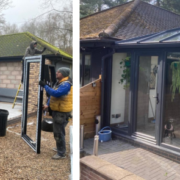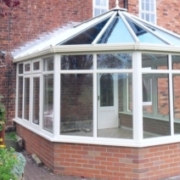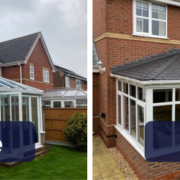What’s The Difference Between an Orangery vs a Conservatory?
Adding extra living space is a great way to enhance your home’s comfort, value, and appeal. Two of the most popular choices are conservatories and orangeries. But when it comes to planning your perfect extension, many homeowners ask: What is an orangery? What is a conservatory? And what is the difference between a conservatory and an orangery?
In this guide, we’ll explore the orangery conservatory difference, how each extension works, and help you decide which one suits your home best.
 What Is an Orangery?
What Is an Orangery?
Let’s start with a common question: what is an orangery extension?
An orangery is a stylish, brick-based extension originally used in the 17th century to grow exotic fruits and plants. Over time, it evolved into a luxurious living space that blends classic architecture with modern functionality.
Today, an orangery is often designed with:
-
Solid brick or stone walls
-
Tall windows for light
-
A partially glazed roof, often featuring a central roof lantern
This makes orangeries more insulated and integrated with the home’s main structure than a typical conservatory.
Still wondering “orangery – what is it?” Think of it as the perfect blend of a traditional extension and a sunlit retreat.
 What Is a Conservatory?
What Is a Conservatory?
A conservatory is a glass-heavy structure that brings the outdoors in. Made with a high ratio of glazing—including a fully glazed roof—a conservatory provides panoramic garden views and a light-filled space.
Homeowners often ask “what is a orangery vs a conservatory?” or “conservatory or orangery – which is better?” The answer depends on how you want to use the space and your style preferences, which we’ll dive into below.
What Is the Difference Between an Orangery and a Conservatory?
When comparing conservatory vs orangery, the main difference between a conservatory and an orangery is in their structure and insulation:
| Feature | Conservatory | Orangery |
|---|---|---|
| Roof Style | Features a fully glazed roof that lets in maximum sunlight, creating a bright and open space ideal for enjoying natural light year-round. | Includes a partially glazed roof, often with a roof lantern, combining natural light with added insulation and a more solid, room-like feel. |
| Wall Construction | Typically built with mostly glass walls to provide clear views of the garden and create a seamless connection with the outdoors. | Constructed with brick pillars or insulated columns, offering a more private and cosy atmosphere with a premium, built-in look. |
| Natural Light | Extremely bright and airy thanks to large glass surfaces, perfect for sunrooms or garden-facing spaces. | Still lets in plenty of light but feels more enclosed and balanced—great for year-round use without excessive glare. |
| Thermal Insulation | Offers moderate to high insulation, especially with modern double glazing and roof upgrades. | Provides superior insulation, making it warmer in winter and cooler in summer—ideal for everyday living spaces. |
| Overall Cost | Generally more affordable, making it a cost-effective option for increasing living space and natural light. | Higher in cost due to the more solid construction and luxury design—but often seen as a long-term investment. |
| Design & Style | Available in a variety of styles from traditional Victorian to sleek, modern designs—great for versatility. | Known for their elegant and substantial appearance, often blending seamlessly with the existing home architecture. |
Conservatories & Orangeries: Key Comparisons
-
Design and Structure:
- Orangery: Orangeries combine brick or stone walls with large windows and a solid, partially glazed roof. They tend to have a more substantial construction, making them feel like a permanent part of the home. The roof is often flat with a central lantern that brings in natural light while maintaining better insulation.
- Conservatory: Conservatories are mostly glass, with minimal brickwork and a fully glazed roof. They have a lighter structure and provide a panoramic view of your garden. This glass-heavy design allows for maximum light, but it also makes conservatories more susceptible to temperature fluctuations.
-
Insulation and Year-Round Use:
- Orangery: Thanks to their solid walls and partially glazed roof, orangeries provide better insulation and are more suitable for year-round use. They maintain consistent temperatures, making them comfortable during both summer and winter.
- Conservatory: Conservatories, being mostly glass, can heat up quickly in the summer and become quite cold in the winter unless properly insulated. Modern glazing techniques, such as double glazing or solar control glass, can help improve insulation, but they still tend to be more temperature-sensitive than orangeries.
-
Cost:
- Orangery: Orangeries are generally more expensive due to their more complex structure, materials like brick or stone, and higher level of insulation. Their construction is closer to that of a traditional room, and this is reflected in the price.
- Conservatory: Conservatories are typically more affordable, as they require fewer materials and are faster to build. They offer a cost-effective solution if you’re looking to add living space without the larger investment of an orangery.
-
Aesthetic and Style:
- Orangery: Orangeries tend to have a more traditional, elegant style, often blending seamlessly with older properties or those seeking a classic look. The mix of solid walls and windows gives them a more permanent and sophisticated appearance.
- Conservatory: Conservatories provide a modern, airy aesthetic, making them ideal for homeowners looking for a sleek, minimalist extension. The abundance of glass allows for a contemporary design that maximizes light and space.
-
Planning Permission:
- Orangery: Due to their more substantial construction, orangeries are more likely to require planning permission, especially if the structure significantly alters the appearance of your home or exceeds specific size limits.
- Conservatory: Conservatories often fall under permitted development rights, meaning they may not require planning permission if they meet certain criteria, such as size restrictions and placement.

Orangery or Conservatory: Which Is Best for You?
The choice between an orangery and a conservatory depends on your lifestyle, budget, and how you plan to use the space.
-
Choose an Orangery if:
- You want a permanent, well-insulated room that feels like a natural extension of your home.
- You prefer a more traditional or elegant style that blends with the architecture of older properties.
- You’re looking for a space that can be comfortably used year-round.
-
Choose a Conservatory if:
- You’re looking for a cost-effective way to add extra living space.
- You want a bright, airy room that allows you to enjoy garden views and natural light.
- You have a modern property and prefer a sleek, contemporary design.
Conservatory and Orangery Extensions from Select Windows
Both orangeries and conservatories offer unique benefits, and the right choice depends on your specific needs. An orangery provides a more substantial, well-insulated extension that can be used all year long, making it ideal for homeowners seeking a permanent addition. A conservatory, on the other hand, offers an affordable, light-filled space perfect for enjoying your garden and brightening up your home.
At Select Windows, we offer a wide range of bespoke orangeries and conservatories to suit your style and needs. Get in touch today to discuss which option is best for your home and start your extension journey with us!











